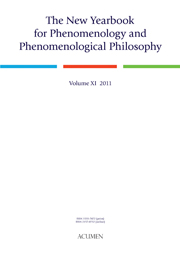Book contents
- Frontmatter
- Contents
- Articles
- Discussion
- Jacob Klein's Two Prescient Discoveries
- On the Mathematical Representation of Spacetime: A Case Study in Historical–Phenomenological Desedimentation
- Splitting the Movάς: Jacob Klein's Math Book reconsidered (Part I)
- History of Physics and the Thought of Jacob Klein
- Jacob Klein on the Dispute Between Plato and Aristotle Regarding Number
- Klein on Aristotle on Number
- The Philosophical Achievement of Jacob Klein
- In Review
- Conclusion
On the Mathematical Representation of Spacetime: A Case Study in Historical–Phenomenological Desedimentation
from Discussion
- Frontmatter
- Contents
- Articles
- Discussion
- Jacob Klein's Two Prescient Discoveries
- On the Mathematical Representation of Spacetime: A Case Study in Historical–Phenomenological Desedimentation
- Splitting the Movάς: Jacob Klein's Math Book reconsidered (Part I)
- History of Physics and the Thought of Jacob Klein
- Jacob Klein on the Dispute Between Plato and Aristotle Regarding Number
- Klein on Aristotle on Number
- The Philosophical Achievement of Jacob Klein
- In Review
- Conclusion
Summary
Abstract: This essay is a contribution to the historical phenomenology of science, taking as its point of departure Husserl's later philosophy of science and Jacob Klein's seminal work on the emergence of the symbolic conception of number in European mathematics during the late sixteenth and seventeenth centuries. Since neither Husserl nor Klein applied their ideas to actual theories of modern mathematical physics, this essay attempts to do so through a case study of the concept of “spacetime.” In §1, I sketch Klein's account of the emergence of the symbolic conception of number, beginning with Vieta in the late sixteenth century. In §2, through a series of historical illustrations, I show how the principal impediment to assimilating the new symbolic algebra to mathematical physics, namely, the dimensionless character of symbolic number, is overcome via the translation of the traditional language of ratio and proportion into the symbolic language of equations. In §§3–4, I critically examine the concept of “Minkowski spacetime,” specifically, the purported analogy between the Pythagorean distance formula and the Minkowski “spacetime interval.” Finally, in §5, I address the question of whether the concept of Minkowski spacetime is, as generally assumed, indispensable to Einstein's general theory of relativity.
Keywords: spacetime; Edmund Husserl; Albert Einstein; Jacob Klein; Minkowski; symbolic mathematics; relativity.
“The only reason he [the relativist] can do his calculations is because he first stripped his datum of any qualitative character and considered it as an abstract number.”
Émile Meyerson, The Relativistic DeductionEinstein's popular exposition of the theory of relativity includes a humorous characterization of the process of setting up a Cartesian coordinate grid.
- Type
- Chapter
- Information
- The New Yearbook for Phenomenology and Phenomenological PhilosophyVolume XI 2011, pp. 154 - 186Publisher: Acumen PublishingPrint publication year: 2012



